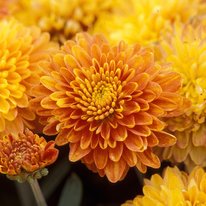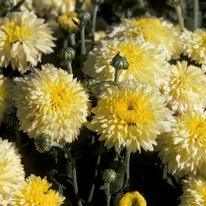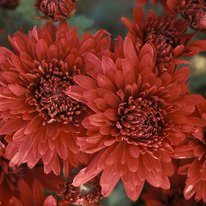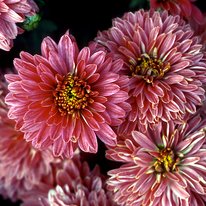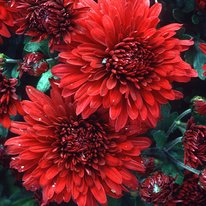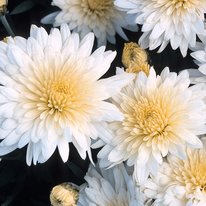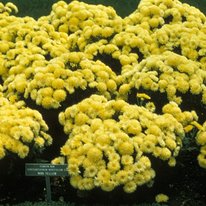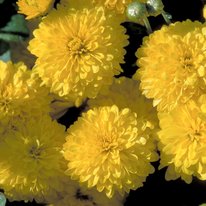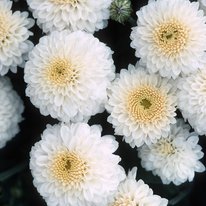Cushion chrysanthemums are dome-shaped with flowers almost completely covering the outside surfaces of each plant, like a pincushion. These hardy and compact plants will grow from 12 to 18 inches tall and wide.
The cushion habit of mums was a genetic discovery of Minnesota Agricultural Experiment Station mum breeders. This was the basis for the U of M's first plant patent for 'Minngopher' in 1977. Previous mums bloomed only at the top of long stems (upright habit). Within a decade, the cushion type became the dominant chrysanthemum plant habit worldwide.
University of Minnesota Cushion Habit Chrysanthemum Varieties
Inca™
- Light bronze, 2-inch, double button flowers
- Early bloom period
- Plants grow up to 12"
- Released in 1996
Lemonsota
- Lemon yellow, 1-inch, pom pom flowers
- Low cushion growth habit
- Early bloom period
- Plants grow up to 12"
- Released in 1988
Minngopher
- Maroon red, 2-2.5 inch, decorative flowers
- Early bloom period
- Plants grow up to 12"
- Released in 1977
Minnqueen
- Bright rose pink, 3 inch, decorative flowers
- Early bloom period
- Plants grow up to 18"
- Released in 1979
Minnrose
- Deep rose pink, 1.5 inch, pompom flowers
- Early bloom period
- Plants grow up to 12"
- Released in 1966
Minnruby
- Ruby red, 2.25 inch, decorative flowers
- Early bloom period
- Plants grow up to 12"
- Released in 1974
Minnwhite
- White, 2 inch, decorative flowers
- Early bloom period
- Plants grow up to 12"
- Released in 1972
Minnyellow
- Lemon yellow, 2 inch, decorative flowers
- Early bloom period
- Plants grow up to 12"
- Released in 1972
Sesquicentennial Sun
- Gold 1-2 inch, fully double pompom flowers
- Flowers are frost tolerant
- Midseason bloom period
- Plants grow 12 to 18"
- Released in 2001
Snowsota
- White with cream center, 1.5 inch, pompom flowers
- Early bloom period
- Plants grow up to 12"
- Released in 1989
Inca™ is a trademark of the University of Minnesota.
Plant size measurements refer to first-year plants properly spaced and grown in full sun.
Bloom period represents average state-wide appearance of first blooms. Early: Starts blooming before September 1; Midseason: September 1-15; Late: After September 15.
Commercialization and licensing
Sesquicentennial Sun is not protected by US Plant Patent or foreign plant breeders' rights, but nurseries propagating this variety can support the U of M breeding program through an agreement with the Minnesota Nursery Research Corporation (MNRC). The MNRC is a non-profit horticultural organization that sponsors scientific research for the commercial growing industry. Since 1957, MNRC has collected voluntary payments from propagators of U of M ornamental and fruit introductions and contributed over $2.5 million to the U of M Department of Horticultural Science. Generous MNRC participants are dedicated to supporting research science and breeding efforts. They believe in the development of cold hardy, disease resistant, prolific and profitable future cultivars and varieties.
If you are a propagator and would like to support the future of the industry by participating in MNRC, please email Pat Bailey, MNRC President, at [email protected].

